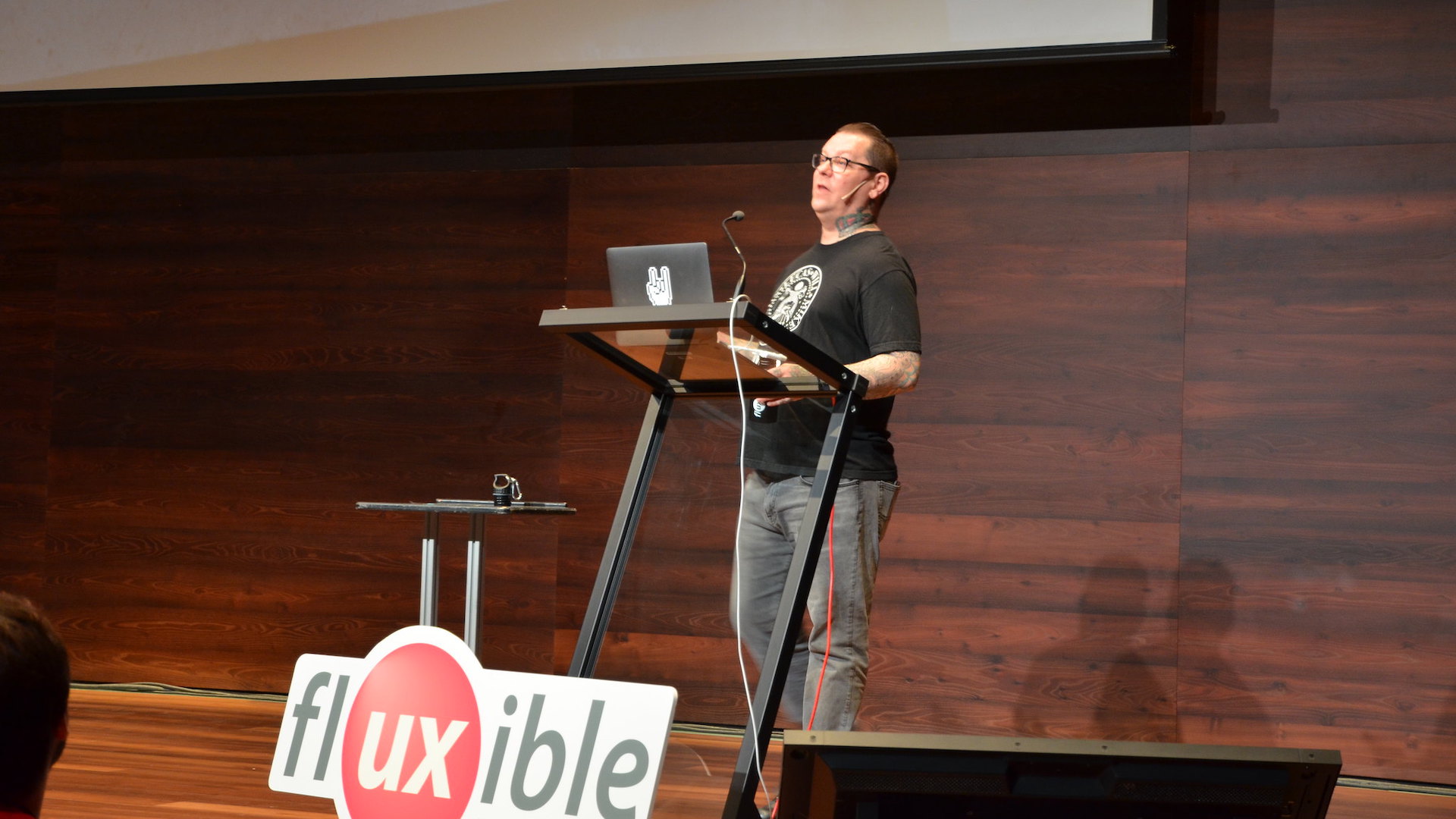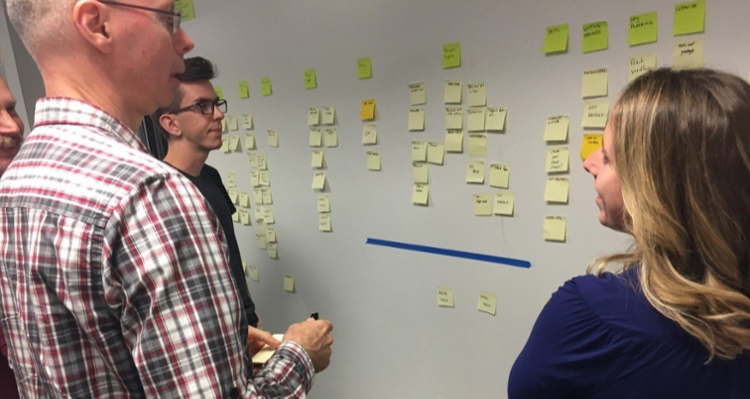UX design is a young practice, but helping give it shape and maturity is a design process that’s about more than just job titles. Part of that process is design critique and it’s something we do twice a week at Zeitspace. (Want to know how UX designers can use design critique to improve their work? Check out our step-by-step guide on how to run a design critique.)
Aaron Irizarry co-authored Discussing Design: Improving Communication and Collaboration through Critique with Adam Connor to help designers understand where critique fits in the design process. The book lays out a structured framework for critique that centres around four key questions: What is the objective of the design? What elements of the design are related to the objective? Are those elements effective in achieving the objective? Why or why not? That structure helps non-designers participate in critique in a productive way, says Irizarry. Critique, says the former Fluxible 2017 speaker, is communication.
I talked to Irizarry about why critique is important, why it’s not just for designers, and how to start a design critique practice in your organization.
Zeitspace: Why is design critique important for you specifically?
Aaron: When we think about the nature of the work we do, design has changed a ton in the last 10 to 15 years. I can remember 10 years ago, everyone was calling themselves a web designer. And now it’s ‘I’m a UX architect. I’m an information architect. I’m a content strategist. I’m an interaction designer.’ What I realized was that regardless of those roles … I still had to have a conversation about whether what I designed was the right thing. I still had to go to the client and say, ‘This is what I designed, what do you think?’ Early on I would just get frustrated because they weren’t telling me what I wanted to hear. I was like, ‘Well that doesn’t help me, I don’t know what simple is or what clean is.’ These are subjective terms. What became clear to me over time is that it would be really helpful for designers to understand how to communicate with non-designers to get the permission they need to improve their work or to even be able to determine if the work is meeting the goals they set out to meet.
Zeitspace: Has the practice of design critique become lost?
Aaron: Software design is still such a young practice, which means we’ve kind of had to make up a lot of it as we go — our titles, or how we approach things. That’s why there’s continually new titles … so critique was always like, ‘Yeah, so we should do that.’ But no one ever said, ‘Actually, this is what the design process should be, and critique could fit here, here, and here in that process, and this is how you should do it.’ We kind of just did it our own way. And in the past several years we’ve gotten so mature in understanding what a design practice, or development process or lean UX or design operations are, we’re starting to see that there is a formal way we can do this that will benefit everybody and strengthen the relationship with our partners. So I don’t think it was ever lost, I just don’t think it was ever entirely found.
Zeitspace: How do you think design critique is making its way through the industry? Is there more awareness now of its importance?
Aaron. I think so. We’ve talked about design in the business ad nauseam over the last several years. We’ve talked about design getting a seat at the table, and how design can really excel when it shows business impact. Well, how are we going to get there if we can’t talk about our work in a way that helps people understand where we’re going? And even if we are, through critique we can show the process of how a design got somewhere and how it actually is rooted in the goals of the business and the customer and that’s where we’re showing the impact.… Critique is communication, so the more we get better at talking about our work objectively, not getting defensive, sharing ideas, and driving conversation — those are skills that are at the heart of critique, but are also at the heart of stakeholder and executive communication as well. So if we’re doing that more regularly, it can prepare us to have better conversations when we do get that so called seat at the table.
Zeitspace: How have you seen critique improve design?
Aaron: One of the things that puts critique in a position to help designers really improve their designs and their relationships with their partners is when you have a structured framework. So if a partner or a designer or anyone in the session knows what type of critique designers are looking for and can give that to them, then the designers get so much better and get better insights. If I can tell them, ‘Here’s what I tried to do, here’s the design workflow or interactions that I used to meet that goal’ and then they're looking at it as, ‘OK they’re trying to meet that goal, they’re trying to accomplish that objective. Did it work? Why or why not?’ Those questions can really help anybody provide critique and give feedback which then leads to better insights, which leads to improvements in design. The information was concise, it was crisp, I understood it. I don’t have to follow up with another meeting later, I know what I need. So if we give people a framework to give critique and feedback the right way it’s … actually an improvement in efficiency and the process.
Zeitspace: In Discussing Design, you write that designers don’t own critique, that it’s a life skill. Why is critique a life skill?
Aaron: So much of what we do is a feedback mechanism and we don’t even know it. I push a button and it either works or it doesn’t work. I try to do something on the computer and it gives me a message that it either worked or not.… Every relationship that we have — work relationships, family members in a home, mentors, siblings, children, whatever — feedback happens consistently.... People think of critique and they think of art and design and think, ‘Oh that’s not for me’. And we really try to say that design doesn’t own critique. It’s a mechanism that we utilize. It’s a tool in our tool belt. It’s a tool that’s not limited to design. Anybody can use it.… So the more that we do it at work and we get better at being objective and not getting defensive and not inviting ourselves to give other people feedback, which can cause them to be defensive, that communication style lends to a better communication style in day to day life.
Zeitspace: What is a good place for companies to start with design critique?
Aaron: If they can do it just within their design teams.… We did a program called critique buddies where we paired people up for a quarter at a time and they met once a week to give one another feedback and talk about their work. What’s really good about that is it gives them a little bit more of a protected space to talk about the work with someone and feel a little bit more comfortable. It’s not so formal that if they say or do something that might be wrong it doesn’t really matter. It gives them a chance to just practice talking about their work. It’s almost like they’re practicing there and then they’re coming to a more structured meeting.
I think while that’s happening it’s really on the leadership of the design group to go to the partners and say, ‘Hey, here’s this program we started with our team where we want to ensure that we’re refining and putting our best foot forward. We would love it if it makes sense if you would join us in this and maybe we just do one once a month.’ Or, ‘We would really love to make this part of our process because we believe the feedback from product and engineering is going to be really helpful for us because product knows the market, the customers, the business goals, and engineering can think about feasibility, they have an analytical mindset.’ So it’s like sharing with them why it would be beneficial and making it very clear this is the value we think we’ll get from doing that and even asking them to just pilot it. And if it’s something that doesn’t seem to be working then we don’t have to continue doing that but it’s really about education and trying to meet partners where they are so that they understand why this new thing on their calendar is worth their time.
Zeitspace: That’s great. Is there anything else you wanted to add?
Aaron: That whole intent piece with critique is so huge. Why am I giving someone feedback? Why am I asking someone for feedback? Really I think there’s just this great need to try to remind folks that this is an objective process, it’s about what we’re building. If someone gives you feedback that maybe something you’ve tried to implement isn’t working, you’re still probably a good person. This is about improvement, not judgement.
Irizarry is speaking at uxWaterloo’s next virtual meetup on May 21, where he’ll talk about successful leadership and share insights, tools and techniques for growing your own leadership skills, overcoming leadership challenges, and successfully developing your teams.
This interview has been edited for length and clarity.





